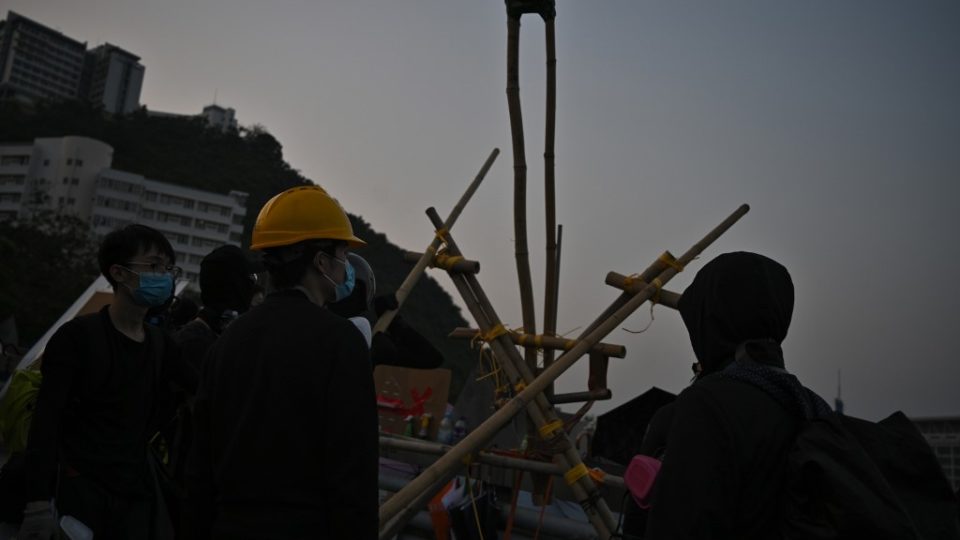Pro-democracy protesters Wednesday stepped up a “blossom everywhere” campaign of road blocks and vandalism across Hong Kong, as students at the Chinese University of Hong Kong — the site of fierce clashes last night — hunkered down for a long stand-off with police.
The new phase in the city’s long-running protests, which has forced schools and shopping malls to close, as well as the shutdown of large chunks of the MTR, came as police in press conference today accused students of harboring a “weapons factory,” and insinuated the force was “wronged and sad” at the widespread scorn they’ve attracted for their heavy-handed tactics in recent days.
Commuters across many parts of the city today faced the increasingly familiar scenario of roads choked with bricks, bicycles, couches, and other materials that had been laid out by protesters overnight to block traffic.
Various lines on the subway — used by more than half of the city’s 7.5 million people daily — were also suspended due to vandalism, forcing many workers to stay at home. Dozens of bus routes were also affected.
Meanwhile, masked protesters dressed in their signature black were locked in a series of tense standoffs at university campuses following battles on Tuesday that continued through the night, with police firing tear gas and rubber bullets.
At CUHK, supply chains sprang up to provide students there with essentials like instant noodles and bottled water.
https://twitter.com/alvinllum/status/1194524031904411648?s=20
Protesters also commandeered CUHK’s kitchens to prep simple meals of, among other things, fried luncheon meat sandwiches.
Similar supply chains had also formed at Polytechnic University.
still in shock at how many people are rallying for Poly U. another car queue forms round the side of the school…opposite the PLA barracks pic.twitter.com/SwtR4ErFMx
— isabella steger (@stegersaurus) November 13, 2019
Highlighting the growing security fears, mainland Chinese students began fleeing Hong Kong on buses and boats back across the border, according to police and universities.
It was not immediately unclear how many students were leaving on Wednesday, although television footage showed dozens of students lining up at a Hong Kong ferry pier purportedly to get on a police boat and be taken away.
CUHK’s student news outlet quoted some as saying they personally didn’t want to go, but felt they had to in order to put their parents’ minds at ease.
17:54 These mainland students are leaving the campus for Shenzhen. They tell Varsity they don’t really want to leave the university but their parents are concerned for their safety. One says, “I want to reassure them. It’s the most important reason why I’ve decided to leave.” pic.twitter.com/izhxQyjk9n
— Varsity CUHK (@varsitycuhk) November 13, 2019
As of press time, CUHK had just announced that it was cancelling the rest of the semester, while other universities announced similar suspensions of classes.
The chaos of the past few days was part of the largely anonymous protest movement’s new strategy of “blossom everywhere,” in which small groups of people target as many parts of the city as possible to cause maximum disruption and stretch police resources.
Protesters had until this week largely confined their actions to evenings and the weekends. The campaign began with an effort to shut down the train network and enforce a city-wide strike on Monday.
The already tense atmosphere escalated on Monday when a police officer shot an unarmed 21-year-old protester, leaving him in critical condition.
The shooting, broadcast live on Facebook, exacerbated fury among protesters and others in society about what they say is excessive police violence.
However, fears have also risen about increasingly violent tactics from the protesters’ side. A masked person on Monday doused a 57-year-old man, who had been arguing with protesters, with a flammable liquid and set him on fire. The man was also hospitalized in critical condition.
Police also condemned protesters in their regular afternoon press conference today, going on to say the widespread criticism of the force and its tactics was “unfair.”
“Police force felt wronged and sad for being ridiculed and scolded by so many members of public for their operations in CUHK, which they were compelled to carry out for public transport and security,” said Chief Superintendent John Tse.
The production of petrol bombs, which he characterized as a “weapons factory,” “necessitate[d] police response, including the use of force… for dispersal,” he added.
Indeed, the scale of the police response was staggering, even by the standards of tear gas-inured Hong Kong. Police fired nearly 1,600 tear gas rounds, more than 1,300 rubber bullets, almost 400 bean bag rounds, and more than 100 so-called sponge rounds yesterday alone.




